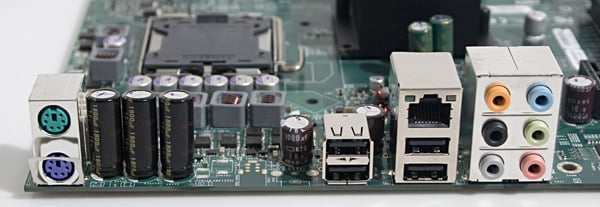Nvidia nForce 650i Ultra Chipset Launch
Design and Features Continued
Looking south on this board, we see an expansion configuration which is fairly run-of-the-mill. We have a single PCI Express x16 graphics card slot teamed up on both sides with PCI Express x1 connectors. The board is also equipped with three 32-bit PCI slots. Near the last PCI slot, you can see USB 2.0 port connectors for four of the eight total onboard USB 2.0 ports.
|
Expansion Slots |
650i Southbridge and SATA ports |
The 650i Ultra's Southbridge supports four Serial ATA-II/300 ports, along with a single Ultra ATA/133 and a single floppy port. The Serial ATA-II/300 ports support RAID connectivity as well, including the whole gamut of levels such as RAID 0, 1, 0+1, and 5. Interestingly enough, the 650i does not natively support eSATA connectivity, although other motherboard manufacturers may add this feature using a third party controller chip onboard.
The I/O panel is about as bare as one can find nowadays, only featuring PS/2 ports to the left along with four USB 2.0 ports, Gigabit Ethernet, and analog audio connectors on the right. The large gap between these ports would typically house eSATA, Firewire, or digital audio ports, but in this case is housing some large capacitors instead, which helps to keep the area around the CPU a little cleaner. With all this spare room, we think it would have made sense to cut in vent openings for the I/O shield to allow some additional airflow to this area.

eVGA nForce 650i Ultra I/O Panel
Onboard audio is connected through Realtek's ALC885 codec, which is located to the left of the expansion slots. The ALC885 is a true HD audio CODEC, with support for both analog and digital audio. However, eVGA's implementation of this only allows for 7.1 channel analog audio connectivity, opting out of supporting true 8-channel S/PDIF audio. Again, as this product is for the budget market, this isn't a huge loss, since analog speakers are by far a more popular choice for budget-class systems.
As for onboard Ethernet, the board is equipped with Marvell's 88E1116 PHY, which utilizes a PCI Express x1 connection to the chipset. Nvidia's software layer allows for Firewall security along with FirstPacket priority optimization through this Gigabit Ethernet port. The chipset does not support Nvidia's TCP/IP acceleration features, which are only offered on nForce 680i/680i LT series products.

Onboard audio and Ethernet controller chips







